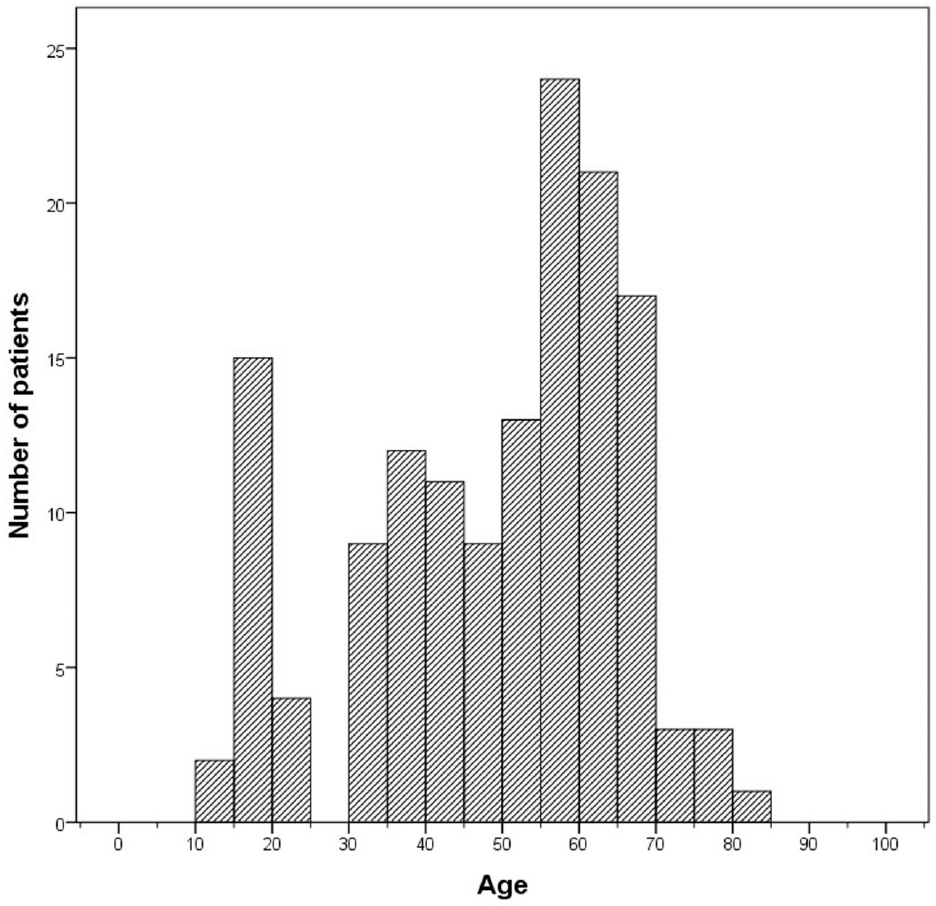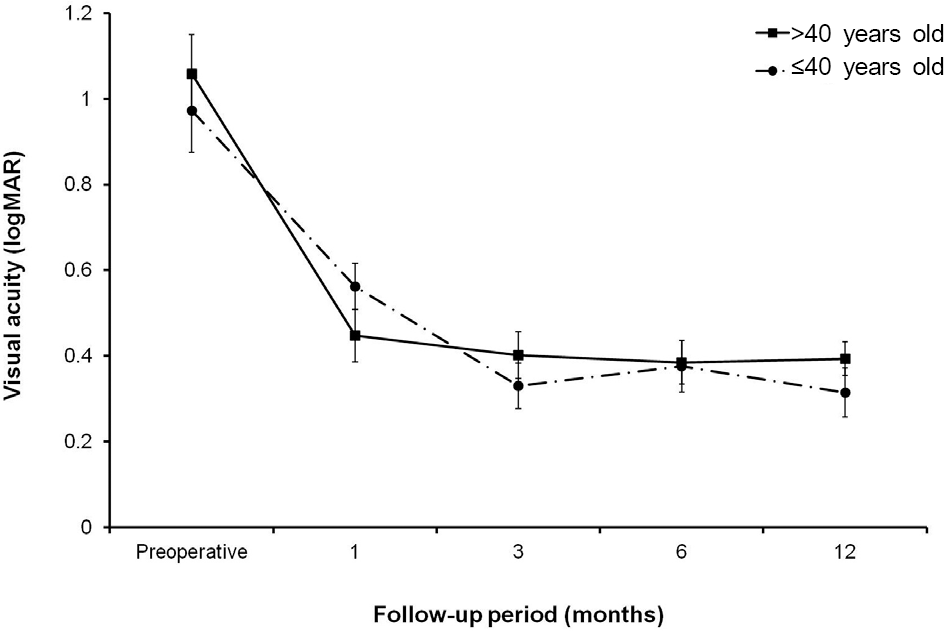Abstract
Purpose
To investigate the clinical features and surgical outcomes of rhegmatogenous retinal detachment (RRD) requiring sur-gery according to age.
Methods
Medical records of patients who underwent surgery for primary RRD between January 2008 and March 2016 were re-viewed retrospectively. Patients were classified into two groups according to age at diagnosis: the under-40 group and the over-40 group. The two groups were compared in terms of demographic features, ocular manifestation, operating methods, pri-mary anatomical success rate, and visual outcome.
Results
One hundred and forty-four eyes from 144 patients were included. Mean subject age was 48.6 ± 16.9 years old. The un-der-40 group involved 42 eyes from 42 patients, and the over-40 group included 102 eyes from 102 patients. Symptom duration was shorter in the under-40 group compared to the over-40 group (7.6 ± 10.7 days vs. 14.5 ± 24.4 days; p = 0.029). Proliferative vitreoretinopathy (PVR) occurred more frequently in the under-40 group (40.0% vs. 17.4%, p = 0.007) than in the over-40 group. The anatomical success rate of primary surgery was significantly different between the two groups; 78.6% in the under-40 group and 91.2% in the over-40 group ( p = 0.038). Preoperative PVR increased the rate of anatomical failure (40.0% vs. 6.2%, p < 0.001). The visual outcomes were not significantly different between the two groups.
References
1. Kuhn F, Aylward B. Rhegmatogenous retinal detachment: a re-appraisal of its pathophysiology and treatment. Ophthalmic Res. 1961; 66:111–24.

2. Heimann H, Bartz-Schmidt KU, Bornfeld N, et al. Scleral buckling versus primary vitrectomy in rhegmatogenous retinal detachment: a prospective randomized multicenter clinical study. Ophthalmology. 1961; 66:111–24.
3. Li X. Beijing Rhegmatogenous Retinal Detachment Study Group. Incidence and epidemiological characteristics of rhegmatogenous retinal detachment in Beijing, China. Ophthalmology. 2003; 110:2413–7.
4. Wilkes SR, Beard CM, Kurland LT, et al. The incidence of retinal detachment in Rochester, Minnesota, 1970-1978. Am J Ophthalmol. 1961; 66:111–24.

5. Törnquist R, Stenkula S, Törnquist P. Retinal detachment. A study of a population-based patient material in Sweden 1971-1981. I. Epidemiology. Acta Ophthalmol (Copenh). 1961; 66:111–24.
6. Chen SN, Lian IB, Wei YJ. Epidemiology and clinical character-istics of rhegmatogenous retinal detachment in Taiwan. Br J Ophthalmol. 1961; 66:111–24.

7. Choi SW, Kim KS, Kim YC. Clinical characteristics of rhegmatog-enous retinal detachment in patients under 40 years of age. J Korean Ophthalmol Soc. 1961; 66:111–24.

8. Sasaki K, Ideta H, Yonemoto J, et al. Epidemiologic characteristics of rhegmatogenous retinal detachment in Kumamoto, Japan. Graefes Arch Clin Exp Ophthalmol. 1961; 66:111–24.
9. Polkinghorne PJ, Craig JP. Northern New Zealand Rhegmatogenous Retinal Detachment Study: epidemiology and risk factors. Clin Experiment Ophthalmol. 1961; 66:111–24.

10. Park SJ, Choi NK, Park KH, Woo SJ. Five year nationwide in-cidence of rhegmatogenous retinal detachment requiring surgery in Korea. PLoS One. 2013; 8:e80174.

11. Lee JW, Song SJ, Park YH. Clinical features and surgical results of rhegmatogenous retinal detachment in children. J Korean Ophthalmol Soc. 1961; 66:111–24.
12. Machemer R, Aaberg TM, Freeman HM, et al. An updated classi-fication of retinal detachment with proliferative vitreoretinopathy. Am J Ophthalmol. 1961; 66:111–24.

13. Byon IS, Pak KY, Lee SM, et al. Lens-save versus phacoemulsifi-cation with intraocular lens implantation in primary vitrectomy for phakic rhegmatogenous retinal detachment. J Korean Ophthalmol Soc. 1961; 66:111–24.

14. Chung H, Lee JH. Clnical analysis of retinal detachment. J Korean Ophthalmol Soc. 1961; 66:111–24.
15. Jeong SK, Park YG, Lee MK. A clinical study on rhegmatogenous retinal detachment. J Korean Ophthalmol Soc. 1961; 66:111–24.
16. Schepens CL, Marden D. Data on the natural history of retinal detachment. Further characterization of certain unilateral non-traumatic cases. Am J Ophthalmol. 1961; 66:111–24.

17. Chignell AH. Retinal detachment surgery without drainage of sub-retinal fluid. Am J Ophthalmol. 1961; 66:111–24.

18. Park JL, Kim SD, Yun IH. A clinical study of the rhegmatogenous retinal detachment. J Korean Ophthalmol Soc. 1961; 66:111–24.
19. Kang SM, Yoon SW, Chin HS, Moon YS. Factors affecting the vis-ual outcome after scleral buckle in rhegmatogenous retinal detach-ment involving macula. J Korean Ophthalmol Soc. 1961; 66:111–24.
20. Baek SK, Lee YH. Primary repair of rhegmatogenous retinal de-tachment using 25-gauge transconjunctival sutureless vitrectomy. J Korean Ophthalmol Soc. 1961; 66:111–24.

21. Lim JW, Ryu SJ. Surgical outcomes for primary rhegmatogenous retinal detachments in patients with pseudophakia after phaco- emulsification. Korean J Ophthalmol. 1961; 66:111–24.
23. Akiba J. Prevalence of posterior vitreous detachment in high myopia. Ophthalmology. 1961; 66:111–24.

24. Kim SG, Huh K, Lee TS. A clinical study on rhegmatogenous reti-nal detachment. J Korean Ophthalmol Soc. 1961; 66:111–24.
25. Sun Q, Sun T, Xu Y, et al. Primary vitrectomy versus scleral buck-ling for the treatment of rhegmatogenous retinal detachment: a meta-analysis of randomized controlled clinical trials. Curr Eye Res. 1961; 66:111–24.

26. Wilkinson CP, Bradford RH Jr. Complications of draining sub-retinal fluid. Retina. 1961; 66:111–24.

27. McPherson AR, O'Malley RE, Butner RW, Beltangady SS. Visual acuity after surgery for retinal detachment with macular involvement. Ann Ophthalmol. 1961; 66:111–24.
28. Laatikainen L, Tolppanen EM. Characteristics of rhegmatogenous retinal detachment. Acta Ophthalmol (Copenh). 1961; 66:111–24.

29. Tani P, Robertson DM, Langworthy A. Prognosis for central vision and anatomic reattachment in rhegmatogenous retinal detachment with macula detached. Am J Ophthalmol. 1961; 66:111–24.

30. Foos RY. Posterior vitreous detachment. Trans Am Acad Ophthalmol Otolaryngol. 1961; 66:111–24.
Table 1.
Baseline characteristics of patients with primary rhegmatogenous retinal detachment
Table 2.
Operation methods for patients with primary rhegmatogenous retinal detachment
| Total | Under-40 group (≤40 years old) | Over-40 group (>40 years old) | p-value | |
|---|---|---|---|---|
| SB | 22 (15%)* | 13 (31%) | 9 (9%) | 0.002 |
| PPV | 121 (84%) | 29 (69%) | 92 (90%) | |
| SF6 | 94 | 20 | 74 | |
| C3 F8 | 21 | 4 | 17 | |
| SO | 8 | 4 | 4 | |
| SB + PPV | 1 (1%) | 0 | 1 (1%) |
Figure 1.
Age-distribution of patients who underwent surgery for rhegmatogenous retinal detachment. The histogram shows bimodal distribution of rhegmatogenous retinal detachment by age.





 PDF
PDF ePub
ePub Citation
Citation Print
Print




 XML Download
XML Download